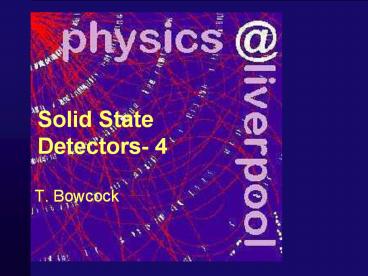Solid State Detectors- 4 PowerPoint PPT Presentation
Title: Solid State Detectors- 4
1
Solid State Detectors- 4
- T. Bowcock
2
Schedule
- 1 Position Sensors
- 2 Principles of Operation of Solid State
- Detectors
- 3 Techniques for High Performance Operation
- 4 Environmental Design
- 5 Measurement of time
- 6 New Detector Technologies
3
Environmental Design
- Design depends on environment the detector is to
operate in and the physics - Many applications
- Space Physics
- Heavy Ions/Nuclear physics
- High Energy Physics
4
Example
- Choose a hostile environment
- LHCb detector
5
LHCb detector
6
B-hadron production
CP effects 10K events
About 1?1012 BB produced/year (108 Gen. 1)
7
Vertex Detector
- Precision tracking that
- identification of B vertices
- measurement of lifetime (40fs)
Bs ? Ds K
8
Geometry
Detectors separated 6cm during injection
small overlap
Positioning and movement to 5mm
10cm
9
Radiation Environment
- Including effects of walls, vessel
- High doses at tips
- (1/r2)
cm
10
Radiation Damage in Si
- Large amounts of radiation (neutron or MIP)
introduces defects into the crystal - More acceptors
- material switches to being p-type
- NeffNd-Na
11
n-strip detectors
NeffNd-Na
12
Radiation Damaged n-strip
- Depletion starts from side with strips
- We can run the detector underdepleted
- Full depletion voltage risesguess
- Many other effects are important
13
Radiation Damage
- Damage increases the numbers of states in the
band gap
conduction band
E
Ea
(p-type)
EEv
valence band
Distribution of energies and properties
14
Trapping
- In particular the effect of some of these defects
is to introduce traps for the charge carriers in
the depleted zone - The traps have lifetimes that increase(from ns to
ms) with radiation dose and affect the pulse
shape/diffusion
15
Ballistic Deficit
Simulation-1D
16
Picking the Technology
- n-strips or p-strips?
17
Comparison of Technology
18
n-strip prototypes
- design
19
IV/CV and Noise
20
Source Tests
Ru source
adc counts
21
Testbeam
22
Resolution
23
Thickness
- Physics
- Signal
- Bias voltage
- depending on technology
- Current
24
Fast Electronics
25
Irradiation
26
Irradiated Detectors
(V. Prelim) Irradiation at 31014
Irradiated (200V)
unirradiated
27
Temperature
- Important operating condition
- leakage currents
- defects dynamics are strongly temperature
dependent - colder is not always better
- Heat Management
- electronics
- ohmic heating in the detector
28
Current versus Temp
29
Depletion Voltage v T
30
Annealing
31
(No Transcript)
32
(No Transcript)
33
Module Design
LHCbUK
Thermal Runaway
LHCb
thick detectors
Single Sided r and ? module
Thermal Model hold cooling at -10C
34
Other factors
- Vacuum
- Inaccessibilty
- Replacement
35
Mechanics
36
Vertex Detector
37
Summary
- To design the detector you have to understand the
environment - design the detector around the requirements
- Radiation damage one of the key factors in modern
experiments

